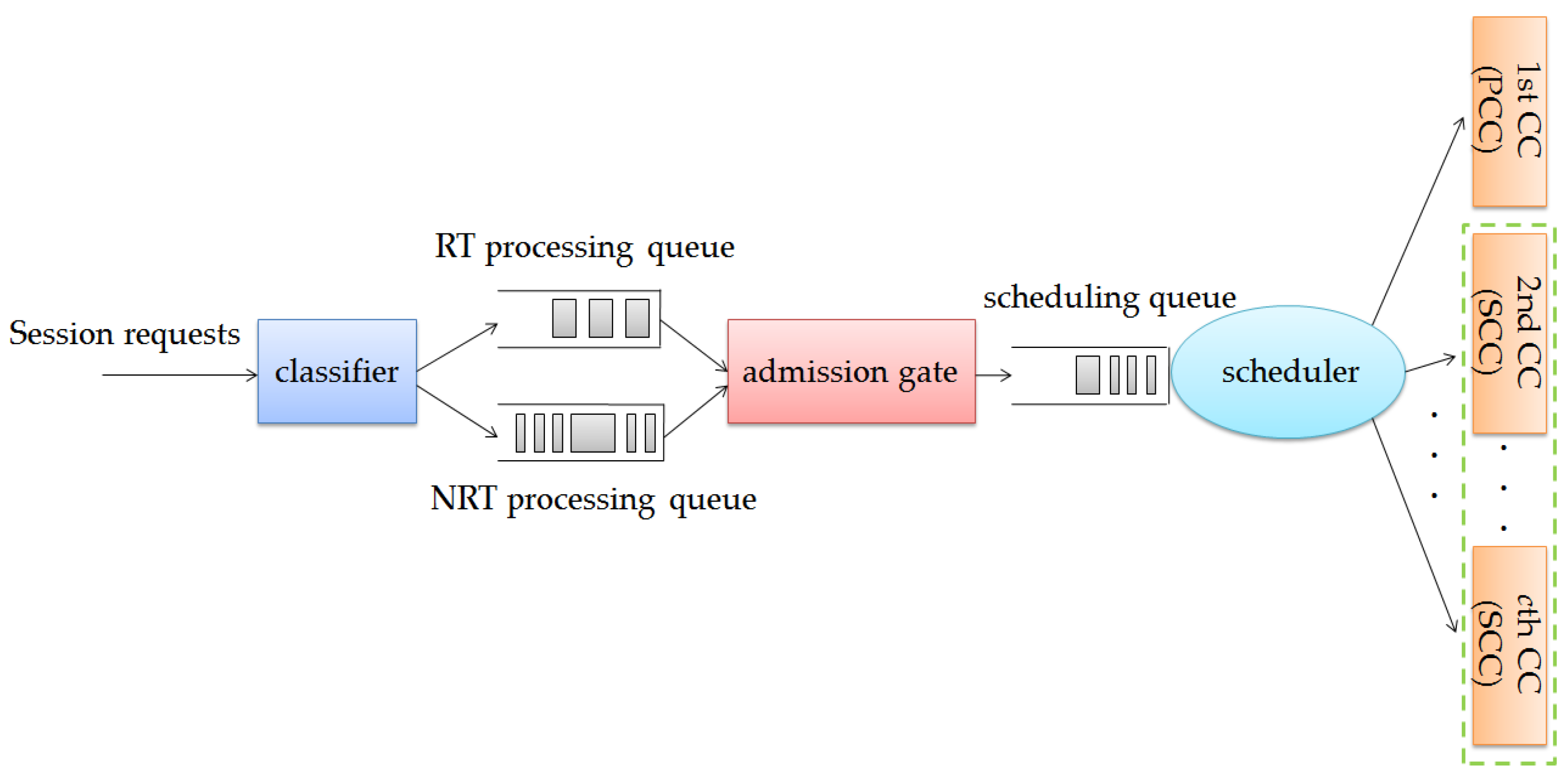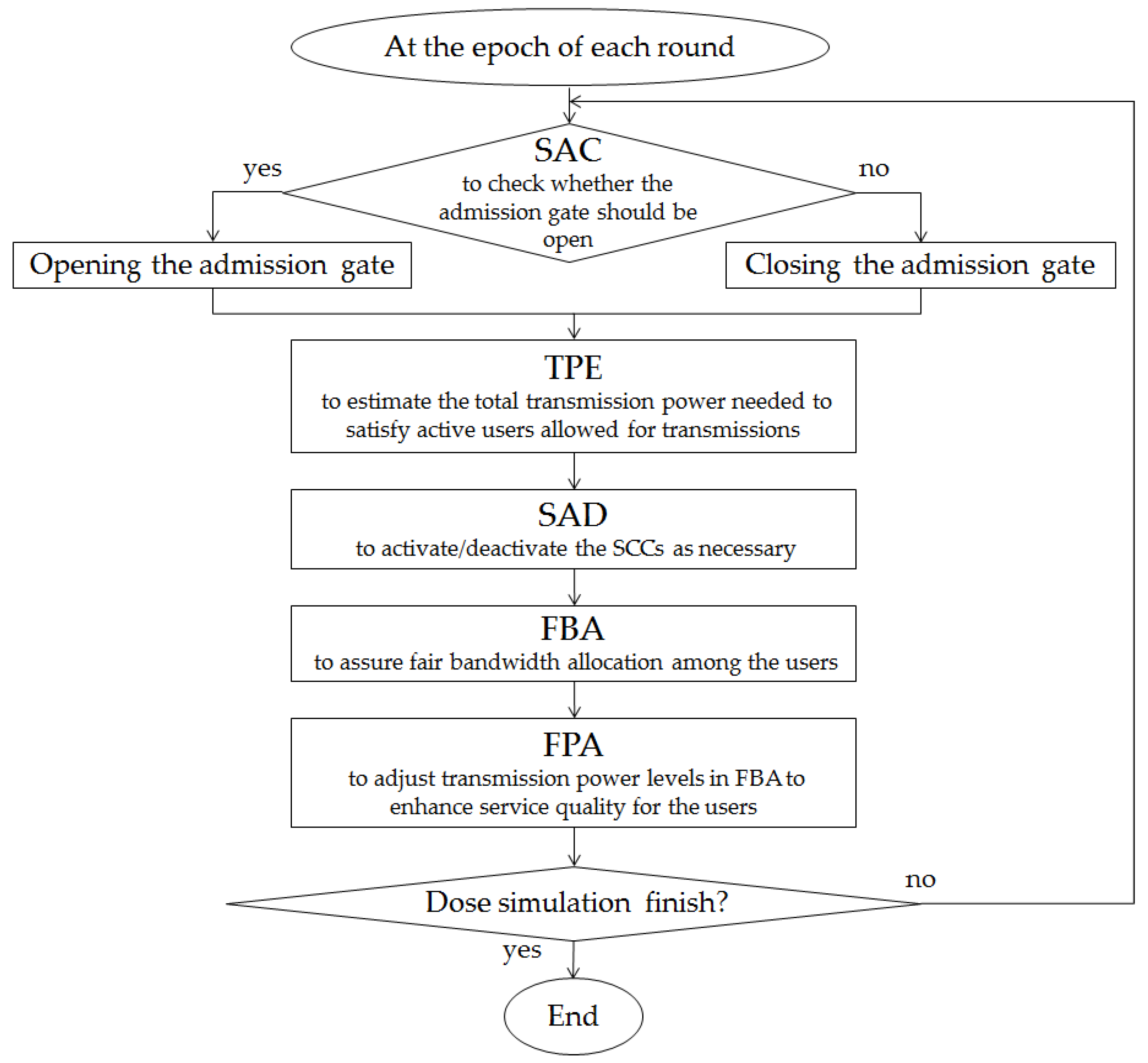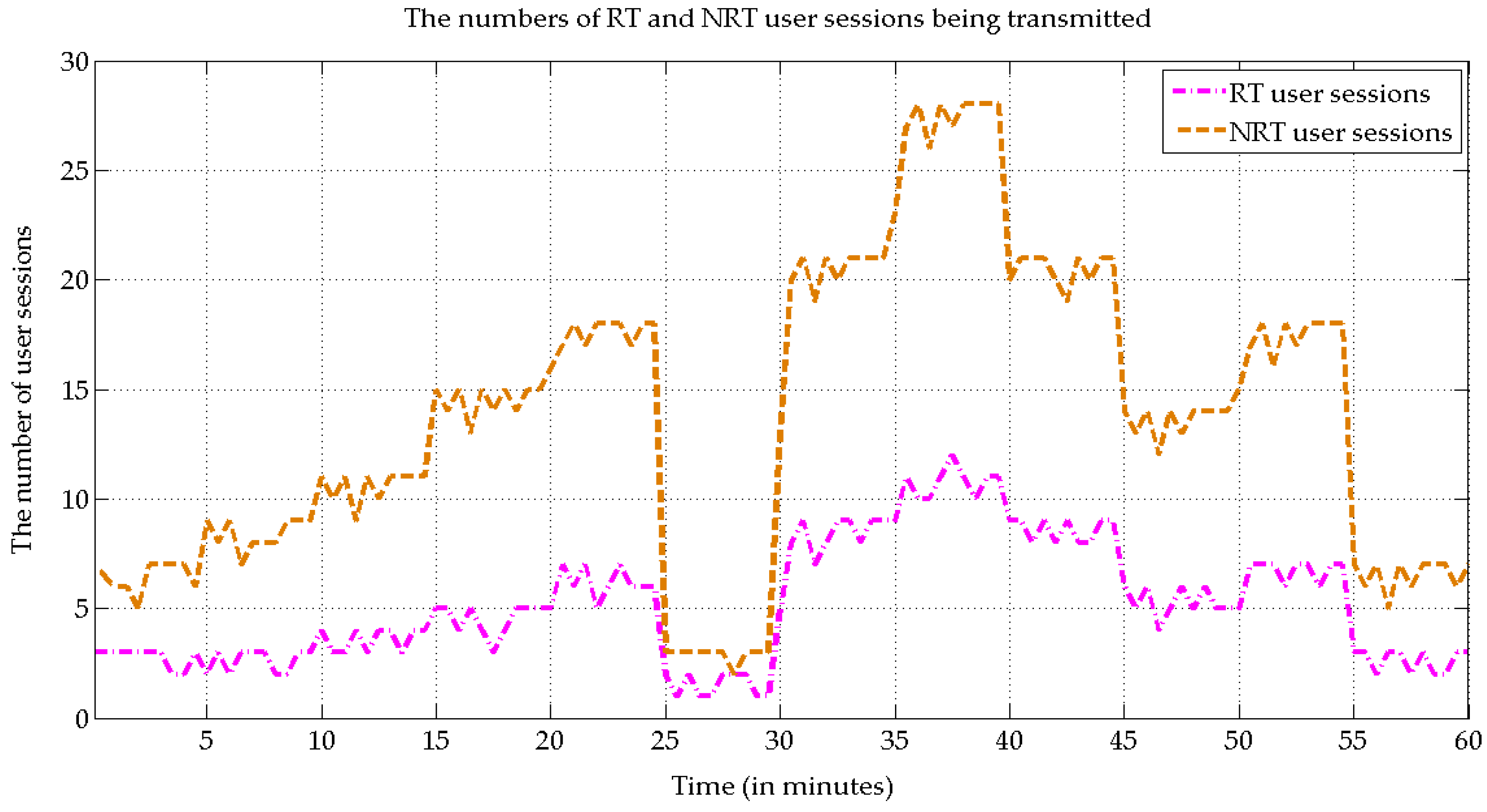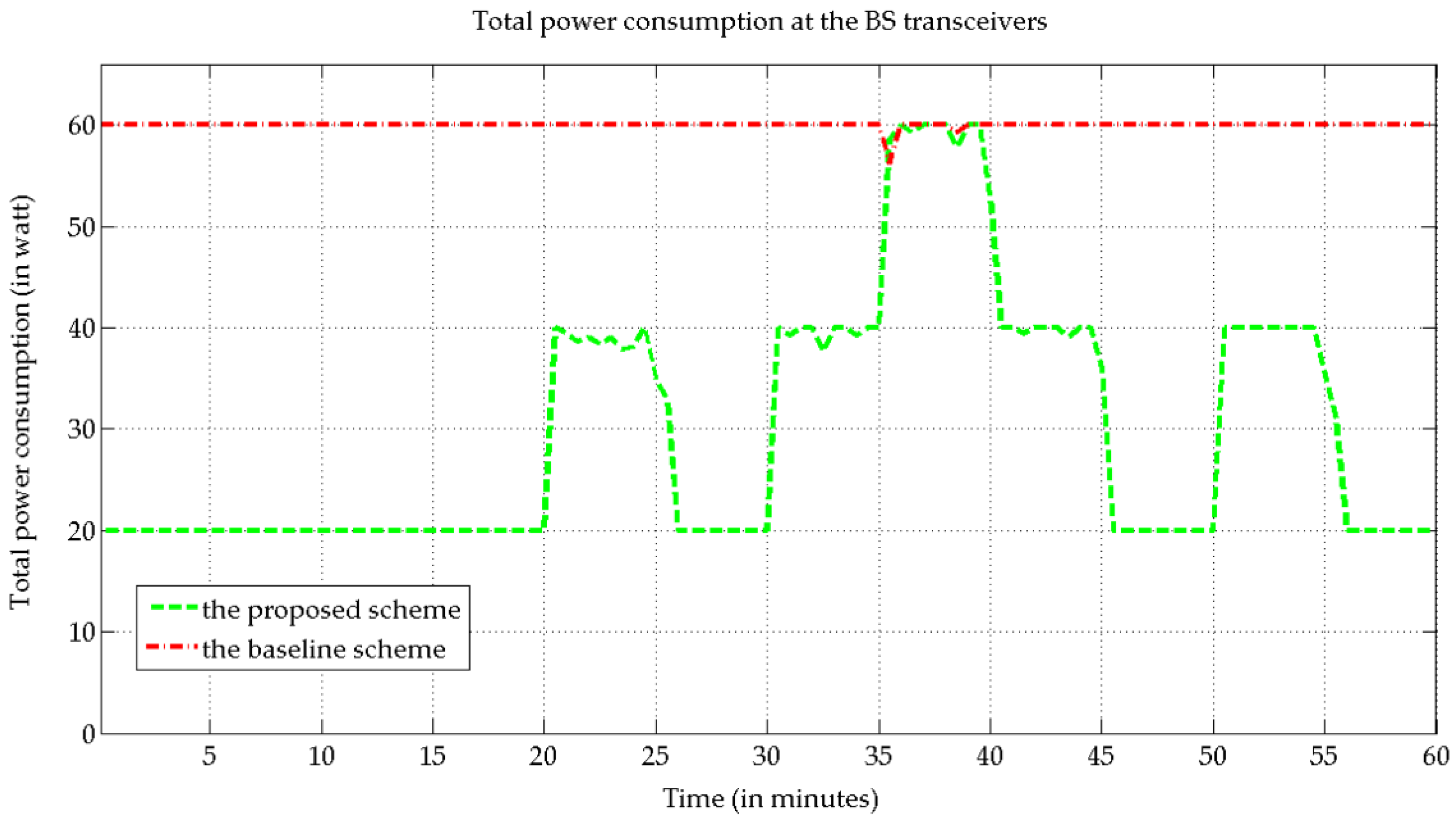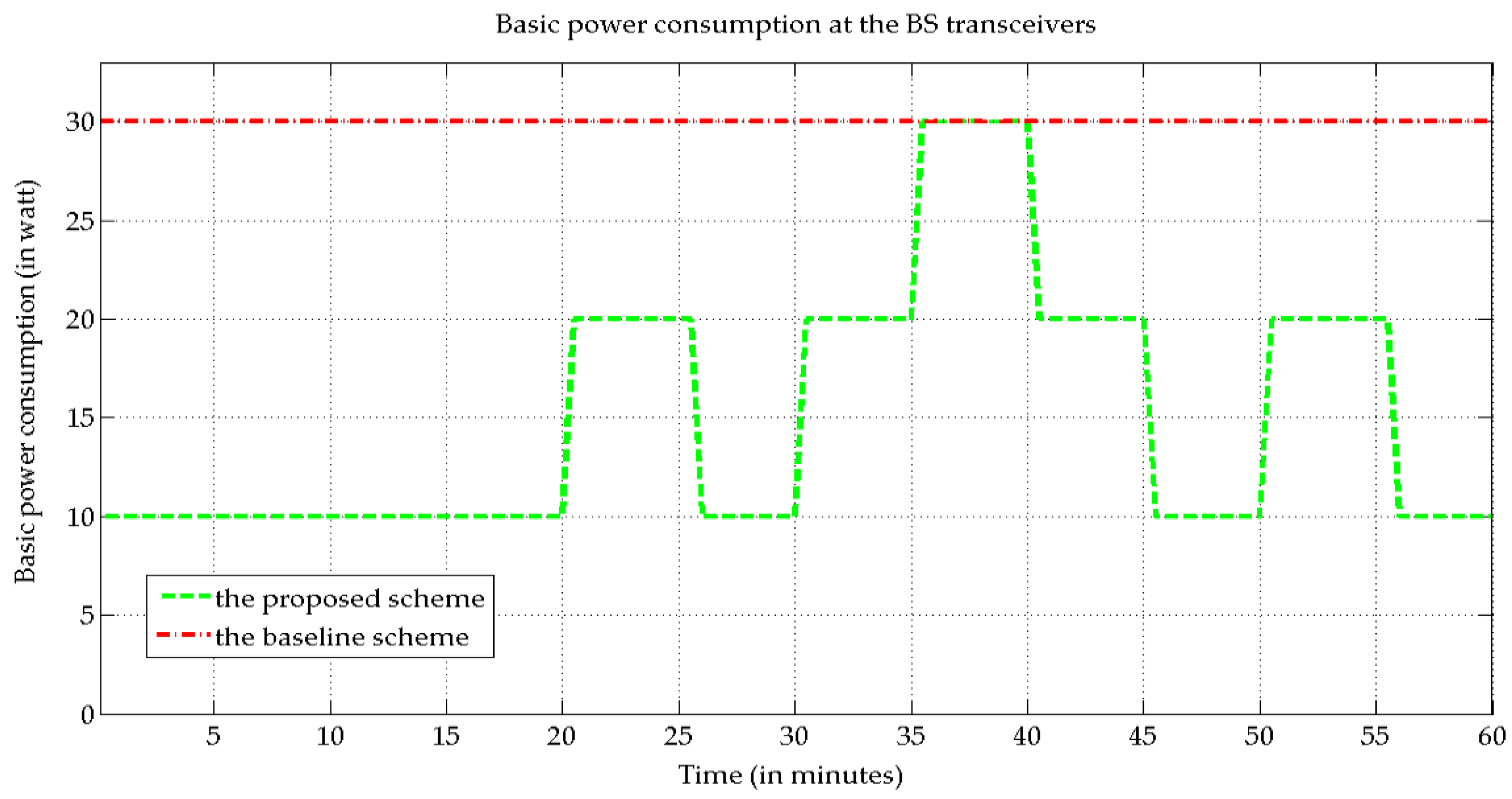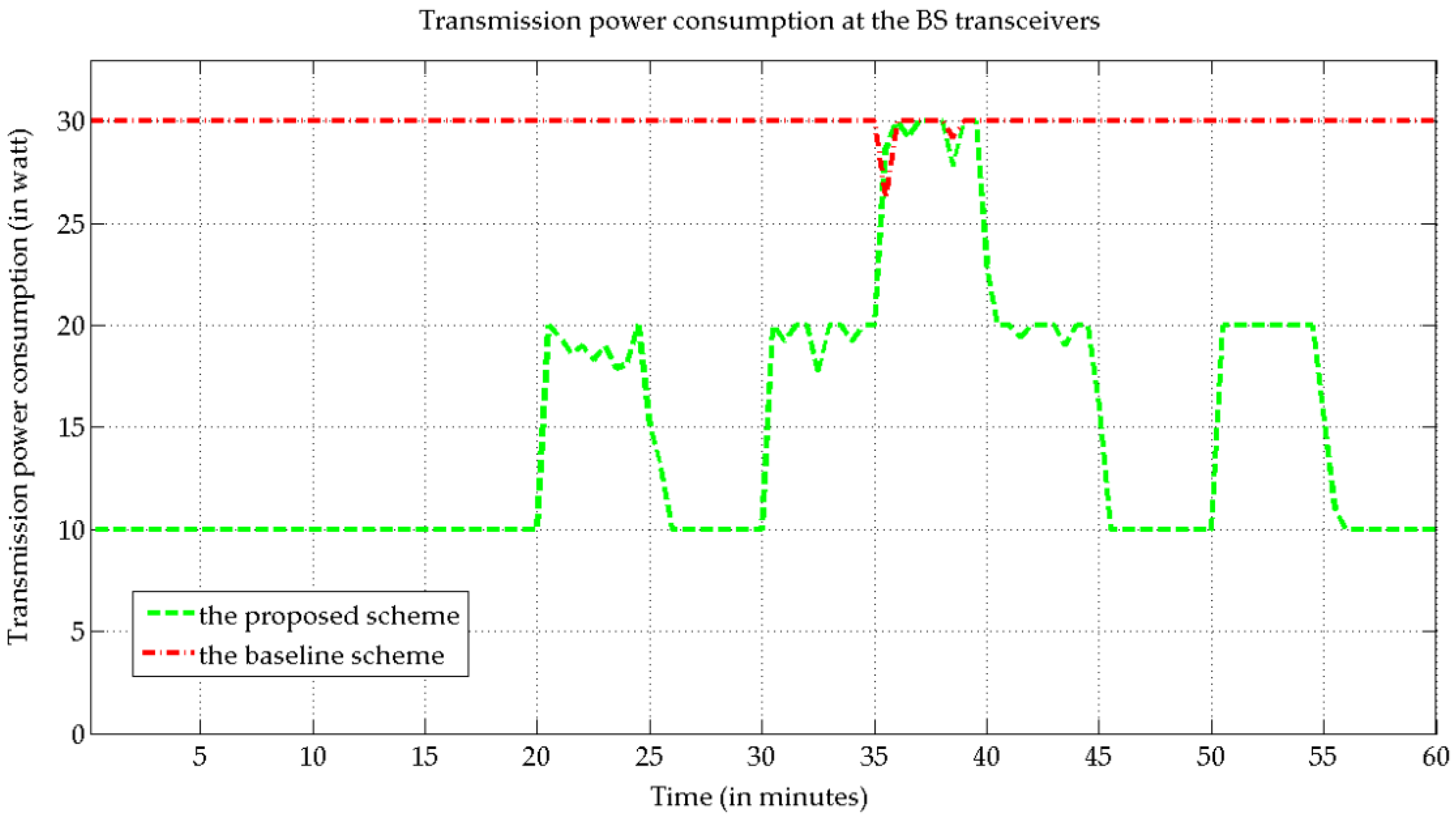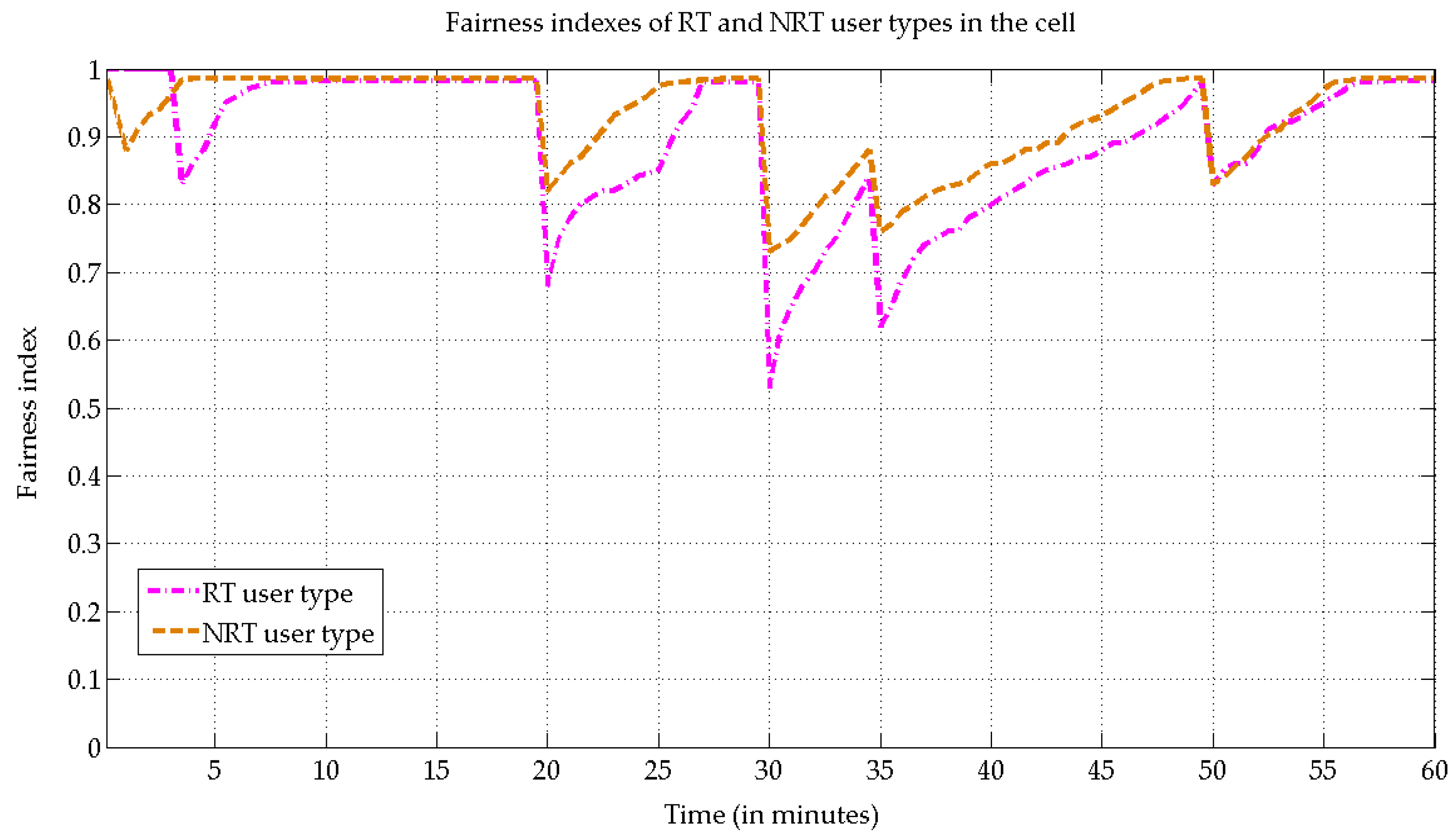1. Introduction
In recent years, 4th generation (4G) cellular systems have been developed and deployed in order to better handle the data demands of ever-increasing numbers of network users, and cellular technologies are even now advancing towards 5th generation (5G) cellular systems and beyond. Importantly, one of the key features of 4G/5G and future cellular systems that allows them to achieve higher capacities than less advanced networks is the ability of base stations (BSs) to utilize multiple component carriers (CCs) together during data transmissions [
1,
2]. At the same time, the power consumed by such wireless networks, especially by their BSs, has become a matter of increasing concern due to rising energy costs and the environmental impacts of the carbon dioxide (CO
2) emissions that accompany energy production. As a result, the concept of green communications has received increasing attention as a potential means of addressing these concerns [
3,
4,
5,
6,
7]. The primary goal of green communications is reducing the overall amount of power consumed by the transmission of communications without causing any reduction in the service quality enjoyed by users.
The primary purpose of developing multi-CC BSs was to provide greater capability in handling very large data-based transmissions, while the concept of green communications relies to a large extent on the fact that these multi-CC BSs should be capable of efficiently reducing the amount of energy consumed by their transceivers. That is to say, the fundamental thinking behind green communication efforts is the idea of enhancing the efficiency of multi-CC BSs so that transmission activities will result in energy savings. As such, ongoing research efforts aimed at exploring how the efficiency of data transmissions from multi-CC BSs can be improved, up to and including the point at which such BSs can be seen as “green BSs”, are essential.
Moreover, it is worth noting that network operators and network users have different goals and preferences when it comes to the issue of radio resource management. Specifically, network users want radio resource allocation to be both fair and sufficient to guarantee their requirements in terms of service quality, whereas network operators are more concerned, given that radio resources are by nature finite, with maximizing the utilization of those resources as much as possible. Accordingly, certain trade-offs are inevitably required given these competing aims of network users and operators, a subject which has previously been explored by various researchers, including, for example, Rodrigues and Casadevall [
8]. However, no past studies have comprehensively examined how the fair scheduling schemes for BSs in multi-CC systems might be refined to yield power savings.
With these points in mind, the goal of the present study was to minimize the amount of power consumed by the operation of BS transceivers with multiple CCs, while still ensuring fairness in resource allocation for various types of users, including the maintenance of sufficient user data rates. To that end, this paper proposes a novel optimization scheme that interprets data transmissions at BSs in a fundamentally different manner than many previously presented resource allocation models. The main contributions of the paper can be summarized as follows:
A novel and efficient transmission scheme for orthogonal frequency division multiple access (OFDMA)-based multi-CC cellular systems that saves power while concurrently supporting both real-time (RT) (delay-sensitive and high data-rate) and non-real-time (NRT) (non-delay-sensitive) types of downlink traffic and maintaining efficient control of fairness indexes for the two types of users based on their respective data usage needs.
By adaptively activating and deactivating CCs during periods of relatively light traffic loads, the proposed scheme can yield significant reductions in the power consumed during data transmission. Thus, the proposed scheme has considerable potential in terms of reducing the energy costs and CO2 emissions associated with cellular networks.
The next sections of this paper are organized as follows:
Section 2 gives an overview of existing related literature in the field.
Section 3 introduces a system model and power consumption model for multi-CC cellular networks and provides a problem formulation for the model to show the objective function to be optimized and define constraints. Next, in
Section 4, a proposed novel transmission scheme for use in the model is detailed, and a time complexity analysis of this scheme is performed. Results in terms of power-saving and fairness performances are subsequently shown and discussed in
Section 5. Finally,
Section 6 relates the conclusions of this study.
2. Related Work
A substantial amount of the past research regarding designs for radio resource allocation in cellular systems has been concentrated on systems utilizing multi-user single-CC BSs, with several studies having given particular attention to various methods used to improve system performance from the standpoint of individual contributions [
9,
10,
11,
12,
13,
14,
15,
16,
17,
18]. More specifically, Wong
et al. [
9] proposed a jointly adaptive bit, subcarrier, and power allocation algorithm as a means of improving the performance of a system. In contrast, in the study by Jeong
et al. [
10], the authors proposed a scheme involving high efficiency cross-layer packet scheduling and resource management. In yet another approach, Kivanc
et al. detailed a set of algorithms relying on greater computational efficiency in determining the allocation of power and subcarriers among system users [
11], whereas Madan
et al. proposed fast algorithms to handle the task of ensuring resource allocation optimization in order to maximize the overall utility of a system [
12]. In another study, the subject of how to allocate resources for energy-efficient communication in the context of single-cell downlink environments with numerous transmitting antennas was addressed by Ng
et al. [
13]. Subsequently, the same researchers extended their research framework further to include multi-cell downlink environments with cooperative BSs [
14]. Meanwhile, a study by He
et al. focused on the physical-layer aspect in its investigation of energy-efficient coordinated beamforming and power allocation in multi-cell downlink environments [
15]. In a still more recent study, Piunti
et al. proposed an optimization framework aimed at minimizing the degree of power consumption while also providing the minimum bit rate required for each mobile terminal [
16]. Still another approach utilized the development of heterogeneous network deployments with macrocells and small cells in order to enhance energy efficiency [
17,
18]. Nevertheless, although each of these studies (
i.e., [
9,
10,
11,
12,
13,
14,
15,
16,
17,
18]) made some important contributions, none of them looked explicitly at multi-CC BSs or the important subject of energy savings. As such, their contributions, while valuable, do not have much direct relevance to the growing concerns regarding energy consumption and associated CO
2 emissions discussed in the introduction above.
Nonetheless, as regulatory agencies and people in general have become increasingly aware of the environmental problems linked to energy usage, the subject of green communication technologies, including green cellular systems, has become the focus of a major trend in communications research [
3,
4,
5,
6,
7,
19,
20,
21,
22,
23,
24,
25,
26,
27,
28]. Several important studies [
3,
4,
5,
6,
7], for example, have sought to provide overviews of the various issues related to energy consumption in communication networks. In terms of directly practical research, meanwhile, Niu
et al. [
19] authored a study proposing a cell-zooming-based energy-saving algorithm aimed at providing dynamic adjustments to the transmission power of BSs, while the energy-saving management group of the 3rd Generation Partnership Project (3GPP) presented a number of network architectures aimed at providing energy savings on a system-wide basis [
20]. Micallef
et al. [
21], meanwhile, proposed an energy-saving algorithm aimed at exploiting variations in network traffic levels in the context of dual-cell high speed downlink packet access systems. Relatedly, Lorincz
et al. looked at methods for managing the levels of power used by network devices in the context of realistic traffic patterns as a means of minimizing the overall amount of energy consumed by wireless access networks [
22], while Chung and Tsai proposed a model aimed at optimizing both CC activation/deactivation and radio resource allocation in order to save power during BS transmissions [
23]. A second study by Lorincz
et al. proposed an optimization model taking the issue of voice-based transmissions into account in order to better ensure that cellular system resources are allocated in an energy-efficient manner [
24]. On the other hand, a hybrid model aimed at providing energy efficiency evaluations for converged wireless/optical access networks was proposed by Aleksic
et al. [
25], while in a study by Enokido and Takizawa, the authors proposed an algorithm dedicated to reducing the total amount of power consumed in distributed models [
26]. More recently, Chung proposed a rate-and-power control scheme for the BS transmission to address the problem of energy minimization at BS transceivers while also ensuring required service quality and fairness for all users [
27]. After that, Chung further constructed a practical framework for addressing energy-efficient BS transmissions based on the involvement of both radio resource allocation and CC activation/deactivation [
28].
Nonetheless, while the aforementioned studies authored by Micallef
et al. [
21], Chung and Tsai [
23], and Chung [
27,
28] did explicitly investigate the issue of energy savings as it relates to BSs with transceivers, the designs utilized in those papers would still not be sufficient to fully address the real-world network environments of the near future. More specifically, Micallef
et al. [
21] did not consider the emerging context of 4G BSs, whereas Chung and Tsai [
23] derived their sub-optimal energy-saving transmission algorithm on the assumption of constantly backlogged flows, making the algorithm somewhat less than fully realistic in terms of reflecting system performance given that in real-world situations, traffic is usually dynamic and fluctuating, as opposed to always being backlogged. In addition, the transmission schemes designed by Chung [
27,
28] were not applicable to the cases of BSs with more than two CCs being utilized. Accordingly, to the best of this author’s knowledge, previous studies have yet to fully investigate how to minimize power consumption in relation to multi-CC BS transceivers, especially in the context of the activation/deactivation of multiple CCs. Furthermore, given the aforementioned goal of green communications, the capacity of BSs to avoid wasting power in the operation of their transceivers is only likely to grow in importance.
3. Problem Description
3.1. System Model
For the purposes of the present study, we focused on the downlink data transmissions in an OFDMA-based multi-CC BS system of a single cell. In this scenario, the cell itself is comprised of n user terminals, with each user terminal being indexed as user-k. In this model, the smallest allocation unit for resource scheduling is a sub-channel spanning 12 sub-carriers for which the bandwidth is denoted as bsub. In addition, it is assumed that only a single user can be assigned to a given sub-channel. Moreover, the amount of time, in seconds, spanning a specific number of consecutive OFDMA downlink frames is defined as the smallest transmission unit and denoted as α. The notation s is used to denote the current scheduling round. In this context, α is set equal to 1 in order to avoid re-defining the unit of “power” and in order to allow reasonable required computation time for the scheme employed.
It is further assumed that there are a total of c CCs located in different frequency bands. These CCs, which are indexed by i, can be utilized for transmission. Without loss of generality, for a user with a given specific transmission power, the data rates supported by the CCs in the higher frequency bands are lower than those supported by the CCs in the lower frequency bands. In this study, the CC with i = 1 was regarded as the primary CC (PCC), while the others were regarded as the supplementary CCs (SCCs). For data transmissions, the PCC was always used as the main CC and was thus set to always be activated, while the SCCs were only used when the traffic was relatively heavy in order to supplement the PCC. As a result, there are naturally c kinds of combinations for these SCCs and the PCC. More specifically, if is defined as the set of all the combinations of CC configurations involving at least the PCC, then the configuration status vector in round s can be defined as , where z denotes the index for the configuration being utilized in , and z = 1, 2, …, . Note, then, that = c. We can set z = x to indicate that the CCs with i = 1 to x are activated and that no other configurations are permitted. As such, for a specific configuration z in round s, = 1 if CC-i is activated; otherwise, it equals 0. Furthermore, we also assume that CC-i consists of sub-channels.
Figure 1 presents a conceptual construction of the system model from a systemic point of view, where it is comprised of a classifier, an RT processing queue, an NRT processing queue, an admission gate, a scheduling queue, a scheduler, and
c OFDMA-based CCs. The data of the various users are transmitted at the session level. In the classifier, all the user session requests are categorized as either RT or NRT sessions, and from the classifier, they are then forwarded in sequence to, respectively, either the RT processing queue or the NRT processing queue. If allowed, these session requests then pass, at the start of each scheduling round, through the admission gate, after which they are buffered to the scheduling queue where they then wait for the scheduler to accept or deny their requests for transmissions. For convenience, in some parts of this paper, the NRT users and the RT users are indexed as type-
m users, with
m = 1, 2, respectively. In addition, the term
is used to denote the set of type-
m users in the cell for round
s;
is used to denote the set of active users with session requests awaiting the scheduler decision in the scheduling queue for round
s; and
is used to denote the set of active users whose sessions are actually being served during round
s. Meanwhile, the duration of a delay in addressing a session request from a given user is measured starting from the time the request is forwarded to the RT processing queue or the NRT processing queue to the time his/her data is completely transmitted.
Furthermore, the basic power consumption required by the BS to activate CC-i is denoted with , while is used to denote the total power consumption of all the active CCs in configuration z during round s. Moreover, denotes the bandwidth (in Hz) of CC-i, while the total system bandwidth is denoted by . As such, can also be expressed as while , where and denotes the bandwidth allocated to the active user-k during round s. It is thus implied that, given a specific configuration z, the total fraction of bandwidths occupied by active users during each round can be distributed arbitrarily over any sub-channels of the activated CCs.
3.2. Power Consumption Model
The power consumption model used in this study refers to the simple, linear model presented by Correia
et al. [
3], as that model allows for the efficient evaluation of the total energy consumption of transceivers at a BS. This model considered both the output power and the input power [
3]. The input power is consumed and converted to a certain output power by BS transceivers. This output power is the time-varying radiated power consumed by the BS transceivers that is then used to support user sessions so that their data rate requirements are met; herein, this power is referred to as transmission power. The input power,
i.e., the total power required by BS transceivers, comprises the basic power and the transmission power.
Specifically, we let
denote the transmission power required to support active user-
k, where that active user is from sub-channel-
j of CC-
i in round
s. If we then suppose that the physical-layer coding scheme utilized by future systems will be sufficiently enhanced to achieve the target bit error rate (BER), then according to the analysis of Madan, Boyd, and Lall [
12],
can be calculated as:
Notice that in Equation (1), for round s, denotes the physical-layer data rate for user-k from sub-channel-j of CC-i, denotes the noise power spectral density, indicates the channel gain betweensub-channel-j of CC-i, and , where ε denotes the target constant BER. Furthermore, is used to denote the maximum transmission power allowed for CC-i.
3.3. Problem Formulation
In this study, our ideal goal, for each scheduling round, was to minimize the overall power consumed of the BS transceivers,
, subject to the stipulation that the fairness indexes for the different type-
m users (
i.e.,
m = 1, 2),
, needed to be maintained at their respective desired target values,
, and, furthermore, that the data transmission rates of the active users,
,
, had to be achieved at their respective minimum required levels,
. Furthermore, we let
denote the set of available radio resources for round
s and let
denote the set of the radio resources assigned to active user-
k in
during round
s. Under those conditions, the optimization problem for each round could then be formulated as follows:
subject to:
;
,
m = 1, 2;
,
;
,
i = 1, 2, …,
z;
,
,
.
Using Jain, Chiu, and Hawe’s fairness index formula [
29],
can then be expressed as:
where
denotes the fairness index for the given user-
k. Furthermore, according to the aforementioned work by Rodrigues and Casadevall [
8],
is designed to be calculated by:
where
denotes the average observed data rate for the given user-
k until round
s − 1 (which can be determined using various smoothing methods (for an example of a convergence analysis of smoothing methods, please refer to the study by Liu and Wang [
30]), such as exponential filtering methods) and
denotes the delay in addressing any session request for user-
k till round
s.
At this point, one can ascertain that the considered optimization formulation constitutes an integer-nonlinear programming problem. However, an integer-nonlinear optimization problem is highly complex, meaning that in order to find the optimal solution for such a problem, an exhaustive search is generally required; in other words, a problem of this type can be viewed as numerically tractable. Moreover, no optimal solution will be possible when the traffic load is so high that it exceeds what the system can handle. Consequently, in light of the structure of the considered problem, we instead propose, in the following section, a heuristic power-saving transmission scheme that achieves efficient control of fairness for each type of user while also maintaining the data rates for those users at levels above their respective minimum requirements.
4. Proposed Scheme
The scheme proposed and presented herein is composed of five components, namely, the session admission control (SAC), transmission power estimation (TPE), SCC activation/deactivation (SAD), fair bandwidth allocation (FBA), and fair power adjustment (FPA) components.
The significance of each individual component is described as follows. The SAC component is used to periodically determine whether the system should accept or deny new session requests to maintain the data rates of the users being served. The TPE component is utilized to estimate the total transmission power needed to satisfy the active users that have been granted admission by the SAC. The SAD component is employed in order to activate/deactivate the SCCs as necessary in order to meet the needs of the active users as determined by the TPE. The FBA component is used to ascertain which active users should be assigned to which individual sub-channels in order to maintain the fairness indexes of the different types of users at acceptable levels. The FPA component is then utilized to further adjust the transmission power levels for the individual sub-channels scheduled by the FBA in order to enhance the channel efficiency (which is accomplished by employing the water-filling concept) and maintain the required minimum data rates of the users selected by the FBA.
Moreover, the SAC component is employed in the admission gate, while the TPE, SAD, FBA, and FPA components are employed in the scheduler. A conceptual flow chart of the proposed scheme is presented in
Figure 2.
Notice that the SAC component constitutes the first operation executed at the beginning of every round for the purpose of scheduling session requests. In addition, the average signal-to-noise ratios for those CCs which are activated will be estimated on a periodic basis (i.e., during each round) by the individual users, and those estimates will then be sent back to the BS. Given all the conditions stipulated above, a detailed description of the entire proposed scheme is provided in the following subsections.
4.1. Session Admission Control (SAC)
At the start of each round, the mechanism will check to determine whether or not incoming session requests from the RT or NRT processing queues should be allowed to proceed through the admission gate to join the scheduling queue to access the network. Define as the number of non-occupied sub-channels in the system during round s. The key feature of the scheme’s design is that if , the admission gate is opened to allow some type-m user requests to enter the scheduling queue based on the ratio of the type-m users’ required data rate to the required data rate of all the users in the processing queues; otherwise, those session requests in both the RT and NRT processing queues are not allowed to enter the scheduling queue (i.e., the admission gate is kept closed). This design effectively ensures that both the data rate of the users in and the fairness indexes for the different types of users can be maintained as well as possible at certain levels.
To facilitate description, define
as the set of type-
m users in the processing queue until round
s, while also defining
as the average required data rate of those type-
m users in
. In addition, let
denote the number of type-
m user requests in the respective processing queues that are permitted to proceed to the scheduling queue in round
s. The following pseudo code details the exact operation of this component:
If ()
, m = 1, 2;
Else , m = 1, 2.
4.2. Transmission Power Estimation (TPE)
After the completion of the SAC component, the total transmission power needed is estimated. This is accomplished by estimating the transmission power required by every session of the respective users currently being served in , as well as by estimating the transmission power required by every session of the respective users in .
First,
is defined as the estimated transmission power for the sessions being served in the current round; it is calculated as follows:
Notice that in Equation (4), denotes the estimated version of , indicates the estimation of , and denotes the set of currently assigned radio resources for user-k in .
Next, the transmission power, denoted as
, needed to meet the data rate demands of the users in
for this round is estimated. To minimize the total amount of power consumed, we simply pre-set the minimum required data rate for each user in
for approximate estimations. Thus,
can be calculated as:
under the assumption that only a single sub-channel is assigned to an active user session. Notice also that in Equation (5),
denotes the estimation of the average channel gain between user-
k and each sub-channel of the active CCs.
If
is used to denote the above estimated total transmission power, then:
In order to lessen the impact of any undesired fluctuations over a short-term interval, a smoothing exponential filtering version of
, denoted as
, is utilized. Next, the maximum allowable transmission power of the active CCs in the current configuration
z, denoted as
, can be calculated as follows:
with that value being calculated for comparison with
to determine whether
can be supported by the current active CCs.
4.3. SCC Activation/Deactivation (SAD)
In order to actually prevent any unnecessary power consumption, the information of the TPE component is utilized by the SAD component to determine when to turn on (or turn off) any necessary (or unnecessary) SCCs. The following pseudo code expresses the details of this component’s operation:
//Initialize counting variables y1=0 and y2=0 at the first execution of the proposed scheme//
If ()
y1 = 0;
y2 = 0;
z = z; //set that = 0//
Else If ()
y1 = y1 + 1;
y2 = 0;
z = z;
While (y1 = yth) do
z = z + 1;
Else ()
y2 = y2 + 1;
y1 = 0;
z = z;
While (y2 ≥ yth) do
CC-z denies new arrivals;
While (all sessions on the CC-z are completely transmitted) do
z = z − 1.
4.4. Fair Bandwidth Allocation (FBA)
The respective fairness control parameters of the type-
m,
m = 1, 2, users in round
s, denoted as
, must then be obtained to control the fairness index for each type of user around the respective target values. The value of
can be expressed in the form of a stochastic gradient search:
for
m = 1, 2, respectively, where
denotes the step-size parameters for type-
m users.
Since the inherent differing characteristics of the fairness indexes for the RT users and NRT users are respectively used in the calculations for evaluating those indexes, the radio resources are dynamically divided into two parts based on the ratio of the type-
m users’ required data rate to the required data rate of all the users in the scheduling queue. In addition, the design includes the stipulation that each type of user has their own region of greater priority than the other type of users. By dint of this approach, certain relative levels of fairness between the RT users and NRT users can be maintained. Specifically, we use
to denote the subset of type-
m users in
and use
to denote the average required data rate of type-
m users in
. In addition,
is defined, for round
s, as the number of non-occupied sub-channels of CC-
i. Next,
is used to indicate the number of sub-channels of CC-
i for which the NRT users are given higher priority than the RT users to share in during round
s; this term can be calculated as follows:
Meanwhile,
denotes the number of sub-channels of CC-
i for which the RT user sessions are given a higher priority than the NRT user sessions to share in during round
s; this term can be calculated as follows:
Next, we schedule waiting user session requests in the scheduling queue by starting from the unassigned sub-channels of the active CCs based on SAD with the index
i = 1 in the configuration
z. Referring to the aforementioned study by Rodrigues and Casadevall [
8], the optimal fair assignment vector, which is indicated by tuple(
i*,
j*,
k*), can be searched via:
under the assumption that equal power allocation is applied for each sub-channel. Note that in Equation (11),
denotes the weighting factor for user-
k in
during round
s. With appropriate modification of the weighting factor presented in the aforementioned study by Rodrigues and Casadevall [
8] to fit our model,
can be calculated as follows:
The set of optimal tuple(i*,j*,k*)s is the solution that results in a value of closest to the value.
4.5. Fair Power Adjustment (FPA)
After the FBA component is completed, the power applied for the sub-channels selected in Equation (11) is further adjusted on the basis of the multi-level water-filling concept, with the aim being to better meet the requirements of the constraints in the considered optimization problem. For convenience, the term
is defined as the optimal power allocation for sub-channel-
j of CC-
i during round
s, and can be expressed as:
Notice that in Equation (13), indicates the set of active users whose requests have been selected based on Equation (11), is the water level for user-k in during round s of the water-filling problem, indicates the estimated channel gain-to-noise ratio between user-k and sub-channel-j of CC-i during round s, and . Lastly, with regard to those requests from the users in , if their allocated power levels are less than those necessary to satisfy their minimum required data rates, they are forced to continuously wait in the scheduling queue.
4.6. Time Complexity Analysis
In this subsection, a study of the worst-case performance of the proposed scheme in terms of the time complexity as a function of , , and , with , is provided. In the SAC component, the amount of time required to perform comparisons is referred to using the constant a1, while the amount of time required for statements is referred to using the constant a2. In the TPE component, the amount of time required for statements is referred to using the constant a3. In the SAD component, the amount of time required to perform comparisons is referred to using the constant a4, while the amount of time required for statements is referred to using the constant a5. In the FBA component, the amount of time required for statements is referred to using the constant a6. In addition, the FBA component sorts the fair assignment vectors, and the worst-case cost for the FBA component is indicated by . In the FPA component, the amount of time required for statements is referred to using a7 , where a7 is a constant. As such, the worst-case time complexity of the proposed scheme can be calculated as . It should be noted that c typically falls in the range of 2–5 (with an especially high likelihood of being equal to or smaller than 3) in today’s environments. As a result, the complexity should generally be low.
5. Results and Discussion
In this section, numerical examples are presented to compare the power consumption of the proposed scheme for transmitting data in a multi-CC BS system with that of a conventional scheme in order to quantify the amount of power that could be saved by using the proposed scheme. In the conventional scheme, important elements of the proposed scheme, namely, the SAC, TPE, and SAD components, are simply excluded; in other words, all the CCs are constantly activated, regardless of any fluctuations in the traffic load.
For our experiments, the example of a medium-sized urban macro-cell in which the BS utilizes three CCs for data transmissions was considered. Of the three CCs, one was assumed to be in the 700 MHz frequency band, while the other two were assumed to be in the 2 GHz frequency band. Recall that the three CCs were indexed with
i, with
i = 1, 2, and 3, respectively. In addition, the following parameters were also assumed:
Ti = 5 MHz;
bsub = 180 kHz;
pi = 10 W;
ptrans_max,i = 10 W; and one OFDMA downlink frame spans 25 sub-channels. We further assumed that all the users of the cell had a uniform spatial distribution, while the movements of the users were assumed to occur at 3 km/h in random directions. Path loss was assumed as the channel propagation model, with the Hata and COST 231 models being adopted for one CC in the 700 MHz frequency band and the other two CCs in the 2 GHz frequency band, respectively [
31,
32]. The Hata path loss, denoted as
(in dB), is expressed as:
Note that, in Equation (14),
is the carrier frequency for the Hata path loss model, which is herein set equal to 700 MHz,
is the effective BS antenna height (in m),
is the user-terminal antenna height (in m),
is a correction factor for the user-terminal antenna height, which is given by:
and
is the distance between the BS and the user-terminal (in km). In turn, the COST 231 path loss, denoted as
(in dB), is expressed as:
where
is the carrier frequency for the COST 231 path loss model, which is herein set equal to 2000 MHz.
In compliance with the application-layer service trend of the 4G and future 5G networks, we looked at RT sessions consisting of YouTube activities and NRT sessions consisting of file transfer protocol, hypertext transfer protocol, and social network activities as a study case. Session times of RT users were set to have a mean of 3 min and an exponential distribution. For NRT users, 20% of the total file size was assumed to be contributed from file sizes with a truncated lognormal distribution and a mean of 2 MB, while the other 80% was assumed to be contributed from files with a fixed size of 100 kB each. For a given user, the inter-arrival time of user session requests, meaning the period of time between the end of a session and the generation of a new request, was assumed to have an exponential distribution and a mean of 1 s. For the sake of convenience, refers to the set of type-m users in the given cell. For the NRT users, the minimum required data rate was set to 300 kbps, while for the RT users, the minimum required data rate was set to 500 kbps. Moreover, , m = 1, 2, were both set at 1; , m = 1, 2, were both set at 0.1; = 100 m; = 1 m; the threshold yth in the SAD component was set at 10; and the simulation time was set to 1 h.
For demonstrations, the number of users was the variable, with the probability of a given user being an RT user set at 30%, meaning that the probability of a given user being an NRT user was set at 70%. The considered variation in the number of users over time is shown in
Figure 3. In that figure, an increase in users from one time point to the next indicates the addition of new users, while a decrease indicates users leaving the cell. Accordingly, the numbers of RT and NRT user sessions being transmitted versus time in the 3-CC cellular system are respectively shown in
Figure 4. As shown in
Figure 3 and
Figure 4, during the interval from 35 to 40 min, there is a gap between the total number of users in the cell and the total number of sessions being transmitted. This gap is mainly due to the system capacity limit, such that some users’ requests are forced, by the check of SAC, to be buffered in their respective processing queues to avoid causing service quality degradation of other user sessions that are currently being served.
Given the conditions specified above,
Figure 5 presents a comparison of the total power consumption levels of the proposed scheme and the conventional scheme. As shown, the proposed scheme resulted in significantly reduced total power consumption at the BS transceivers during periods of relatively light traffic. This effect was achieved because under the proposed scheme, some SCCs were dynamically deactivated when the traffic load decreased. As such, unnecessary power consumption was significantly reduced even as the respective minimum requirements of all the user sessions were satisfied and the fairness indexes for the different types of users were still efficiently controlled at acceptable levels.
Next, as can be seen in
Figure 3 and
Figure 5, under the proposed scheme, for any periods in which the total number of users was equal to or less than 20, the power consumed by the BS transceivers was consistently reduced to a relatively low level (
i.e., around 20 W). In contrast, under the baseline scheme, the power consumed by the BS transceivers remained at a much higher level (
i.e., around 60 W) for almost the entire simulation. This was due to the fact that, for a given configuration of CCs, if the water-filling approach based on Equation (13) was applied, the maximum available transmission power was completely utilized for distribution over each sub-channel.
Next, in order to more clearly illustrate the behavior of the two schemes with regard to traffic load, we introduce two graphs (
Figure 6 and
Figure 7) in which the results for the basic levels of power consumed and for the levels of transmission power consumed over time, respectively, are plotted. By referencing
Figure 3 and
Figure 6, it can be seen that, under the proposed scheme, the first SCC (CC-2) becomes activated when the number of users is increased to 25, while the second SCC (CC-3) is subsequently activated when the number of users reaches 45. In contrast, when the number of users is relatively low, both of the SCCs are deactivated. These results imply, then, that the proposed scheme can, in comparison to the other scheme, effectively activate/deactivate the SCCs according to uncertain variations in traffic loads over time in order to lessen or prevent unnecessary energy consumption. From
Figure 7, meanwhile, the following fact, which was likewise illustrated above with
Figure 5, can clearly be seen: due to the water-filling approach, the maximum available transmission power was almost fully utilized for any given configuration of CCs under both schemes. Accordingly, the channel efficiency enhanced. The latter point is illustrated in
Figure 8, which shows the fairness indexes for both the RT and NRT users over time.
It was also found, as shown in
Figure 8, that for a specific number of users of the cell, the fairness indexes for the different types of users were nearly convergent, consistently reaching a level of less than 2% difference from the target. Moreover, even when the arrival rate of new users increased significantly, the fairness indexes for both the RT and NRT users were nearly maintained at their respective target levels following no more than a few minutes of scheduling rounds (iterations) (the variable results for each round of the 5-min intervals shown in
Figure 8, where the intervals were based on the traffic pattern indicated in
Figure 3, are unrelated to any of the optimization variables for the power minimization problem being considered. Accordingly, these results do not reflect the stability of the proposed scheme in any way). Relatedly, while the fairness indexes for both types of users were instantly degraded whenever the traffic load was significantly increased, they were still maintained at levels above 0.7 during almost all those brief periods of degradation.
For the sake of completeness,
Table 1 lists the average levels of total power consumption, under the proposed scheme and the conventional scheme, for different minimum required data rates for the NRT users and RT users given the traffic pattern indicated in
Figure 3. As indicated by
Table 1, the proposed scheme outperforms the conventional scheme in terms of power-saving effectiveness for various minimum required data rates for the NRT users and RT users. This better performance results from the proposed scheme having the substantial advantage of flexibility in terms of activating/deactivating the SCCs according to dynamically fluctuating traffic loads, thus allowing unnecessary power consumption to be avoided. In addition, when the minimum required data rates are set relatively low (
i.e.,
= 300 kbps for
and
= 500 bps for
), the resulting power-saving ability is particularly significant (with consumption lowered by 50.26%). This is due to the fact that, under a given a traffic pattern, and as indicated by Equation (1), when the minimum required data rate for each user is higher, the accumulated transmission power will also be larger, which, in the event that the accumulated transmission power exceeds the maximum transmission power of the currently active CC(s), will lead to the activation of more SCC(s) to aid in the transmissions. As a result, more power will be consumed. Meanwhile, when the minimum required data rates are set lower, the resulting power consumption is also lower. For the conventional scheme, on the other hand, because the two SCCs were continuously active regardless of the lightness or heaviness of the traffic load, the level of total power consumption remained close to 60 W almost continuously. Furthermore, as the minimum required data rate was increased, the total power consumed slightly decreased, as can be seen from the column for the conventional scheme in
Table 1. The reason for this is that the possibility of the higher data rate requirement being satisfied is relatively low under heavy traffic load conditions, such that given the FPA design, some sessions may be forced to continuously queue in the scheduling queue, in which case they will not consume power at the BS transceivers.
Essentially, the advantages of the proposed scheme indicated by the above experimental results spring from the fact that the proposed scheme was based on the radio resource and power allocation approach previously proposed by Rodrigues and Casadevall [
8]. The primary aim of their approach was to ensure efficient control of the fairness of resource allocation, and we have simply modified that approach further to fit the purposes of our proposed model. Simply put, the proposed scheme provides powerful power-saving ability, while also satisfying the respective minimum required data rates of all the user sessions and efficiently controlling the fairness of resource allocations to different types of users. More specifically, by monitoring fluctuations in the traffic load and providing dynamic activation/deactivation of the SCCs of the BS accordingly, the proposed scheme significantly reduces any unnecessary consumption of power. Stated differently, the proposed approach allows for efficient use of system resources with regard to power usage, bandwidth efficiency, user fairness, and computational time. Based on the above observations, it can be firmly concluded that the proposed scheme would constitute an effective means of reducing power consumption on the BS side of cellular systems.
